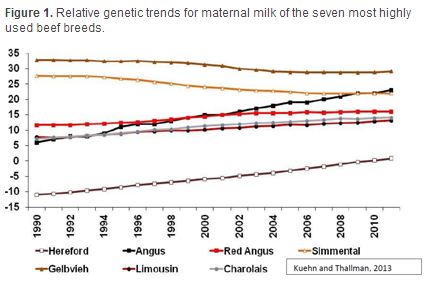



Can Beef Cows Milk Too Much?
Higher yielding beef cows require more feed both through lactation and also for year-long maintenance, according to Cow Calf Feed Specialist, Warren Rusche.The implication of this is that every day the cow and her calves in one the ranch, they will have a higher feed bill.
One of the more significant advancements in beef production has been our ability to more accurately predict the genetic merit of the sires and dams that are used to produce beef, writes Mr Rusche oof South Dakota State University.
The use of Expected Progeny Differences (EPDs) has played a key role in the ability of the beef industry to produce more pounds of beef per cow.
They are a powerful tool that allows managers to more rapidly make progress towards their goals. The flip side of that is that it can be very easy to overshoot the target.
At the 2013 Beef Improvement Federation conference, Dr. David Lalman from Oklahoma State University laid out a compelling argument that the beef industry has done just that when it comes to the genetics for maternal milk.
As shown by Figure 1, most of the most popular beef breeds have seen either a steady increase in the level of milk production, or started out relatively high and have basically remained steady. Taken as a whole, the beef industry has increased the potential for milk production in the cowherd over the last 25 years.
What has happened to cow productivity at the ranch while these genetic changes have been occurring? Dr. Lalman also shared data from both the SPA and CHAPS data bases suggesting that there hasn’t been a great deal of movement in average weaning weights. How could this be? One of the theories discussed is that research data has shown that at increased levels of milk production, the calf becomes less efficient at converting additional milk into calf weight. Another possibility is that there may not be enough feed nutrients available in the environment for the cow’s genetic potential for milk to be fully expressed.
So why could cows with a higher potential for milk production present a problem? The short answer is increased feed costs and nutrient requirements. Most producers recognize that higher milking cows need more feed inputs while they are lactating.
What isn’t as well understood is that those same cows have a higher year-long energy for maintenance requirement as well. That means whether she is milking or not, she (and her calves’) will have a higher feed bill every day she’s on the ranch compared to her herd mate that is more moderate in potential milk production.
Over time those increased in maintenance requirements could lead to one of two outcomes: alter the environment by bringing in more feed, or accept poorer reproductive success rates. The first alternative won’t be cheap, especially with today’s feed costs.
The second results in fewer calves to sell and reduced income. Producers should take a hard look at whether or not the potential increases in weaning weight are enough to overcome the additional resources needed to support that production.
Cowherd management is a balancing act between optimizing productivity and controlling costs. The cost side of the business has certainly changed in the last decade. Given that business conditions have changed, it only makes sense to at least consider if selection practices for traits that impact both costs and revenues need to be adapted as well.



